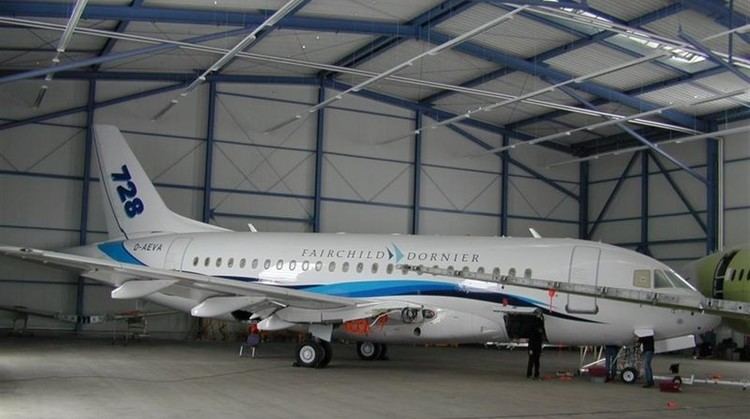 | ||
Manufacturers Fairchild Aircraft, Dornier Flugzeugwerke | ||
The Fairchild Dornier 728/928 family was Fairchild Dornier GmbH's ambitious bid to develop a range of large (50-110-seat) regional jet airliners to supplement the smaller 328JET series. Although the aircraft was a modern design and attracted strong airline interest when launched, the program ended with the insolvency of Fairchild Dornier soon after the official roll-out of the first 728. The 728/928 family is a monoplane design with fixed wings in low wing configuration and two engines mounted under the wings. It has a retractable undercarriage (or landing gear) in tricycle configuration.
Contents
- Development
- Layout
- Component manufacturers
- Operational history
- Variants
- 728
- 928
- 528
- Envoy 7
- Specifications
- References

Development

Dornier Luftfahrt GmbH, which was acquired by Fairchild in 1996 and was renamed Fairchild Dornier in 2000, announced the project, which had begun as the X28JET project and later introduced publicly as the 728JET, in October 1997 at the Dubai Airshow. The new family of regional jets, the 528JET, 728JET and 928JET, seating from 55 to 100 passengers was launched at the ILA Berlin Aerospace Show (International Aviation and Space Flight Exhibition) in Berlin on May 19, 1998 after earlier receiving provisional launch orders from Lufthansa (60 firm orders and 60 options) and Crossair. Crossair later cancelled as a result of the fuselage layout. To prevent Low-cost carriers from equipping the 728 with six-abreast seating, instead of Cityline's five-abreast seating, Lufthansa made Fairchild Dornier reduce the fuselage diameter. It shrunk from the original 3.40 m (11 ft 2 in) to 3.25 m (10 ft 8 in). The reduction also lowered the weight of the aircraft, but brought Crossair to choose the Embraer ERJ-170 family instead.
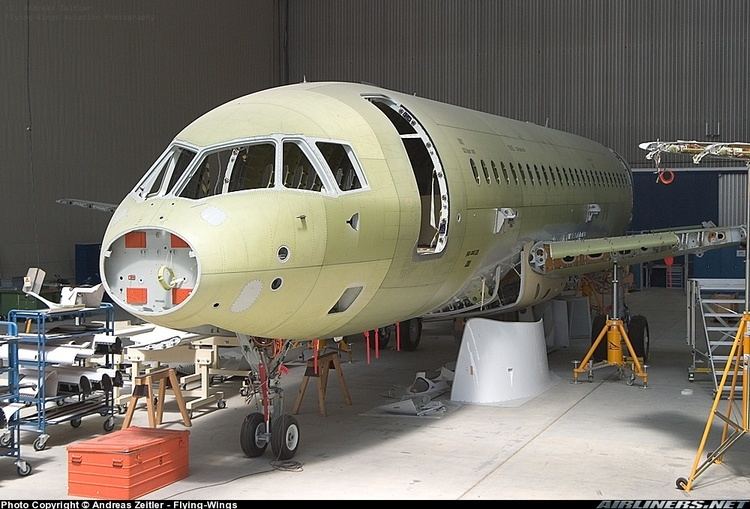
In June 2001, GECAS ordered 50 aircraft firm and additional options up to 100 aircraft. October 2000 saw the beginning of testing of the "Iron Bird" (a mechanical/hydraulic - test rig in 1:1 scale). In March 2001 came the start of the final assembly of the first prototype. In April 2001, General Electric Aircraft Engines (GEAE) began test flights of the CF34-8 engine.
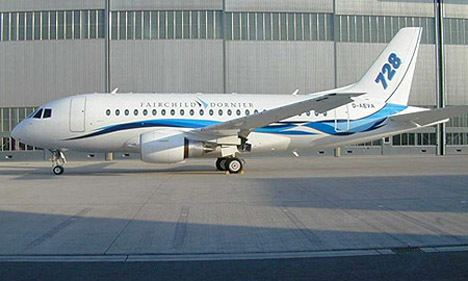
Fairchild Dornier completed the first fuselage in December 2001. In January 2002 the first prototype moved on its own landing gear. With the official roll out of "TAC 01" (Test Aircraft 01 - the first prototype) in March 2002, the 728 was presented to the public for the first time. In March 2002 TAC 03 was transported to IABG in Ottobrunn for structural testing.
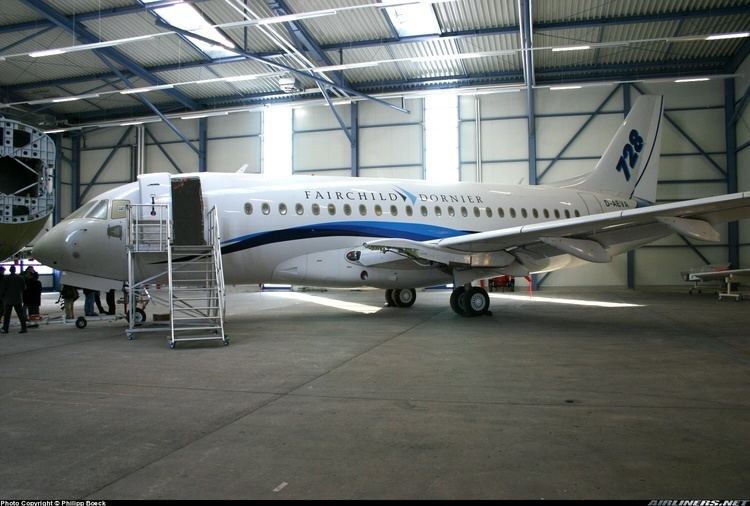
In total, eight customers, among them Lufthansa Cityline, GECAS, Bavaria Leasing, CSA-Czech Airlines, Atlantic Coast Airlines, and SolAir, had (by March 2002) placed firm orders for 125 aircraft and signed options for an additional 164.
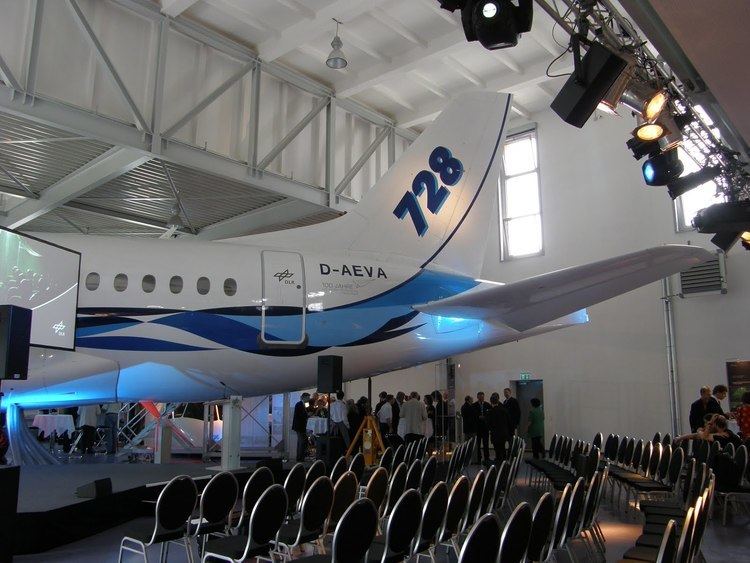
The lead aircraft in the program was the 70 to 85 seat 728 (previously named 728JET), which made its official roll-out on March 21, 2002, and was scheduled to make its first flight in the summer of 2002. Deliveries were expected to start in mid-2003 to Lufthansa Cityline.
However, before the first flight of the 728 had been made, Fairchild Dornier filed for insolvency on 2 April 2002, and the whole program came to an end, due to Lufthansa and GECAS cancelling their orders shortly after. Without the backup of the programs biggest customers the program paused, and the search for new investors began.
In July 2003, D'Long International Strategic Investment Group of Xinjiang, China showed an interest in buying the project. A new firm, Fairchild Dornier Aeroindustries, was formed to develop the aircraft but filed for bankruptcy in 2004. No aircraft were produced although structural tests in Dresden were launched in 2003.
Layout
The 728 is an aircraft with a low wing configuration and two engines mounted one beneath each wing in underwing pods. Like most airliners it is a monoplane with fixed wings and has a retractable undercarriage in tricycle configuration. As usual for this aircraft layout the flight control surfaces are located at the trailing edge of the wings (Ailerons) and at its empennage (stabilizers).
The wing of the 728 is an adapted version of the so-called "TNT" developed by Dornier for the Do-228. TNT is the German abbreviation for "Tragflügel Neuer Technologie" (Wing of New Technology), although novel "Super Shark" blended-winglets were developed and incorporated into the wing design during 2001/2002. The low-wing was new for the Dornier GmbH because the aircraft types built before (Do-28, Do-228 and Do-328) had a high-wing configuration.
Component manufacturers
In August 1998, Fairchild Dornier announced it had selected General Electric's FADEC equipped CF34-8D (which has 87% parts commonality with the CF34-8C1 selected to power the competing CRJ-700) ahead of the SNECMA/Pratt & Whitney Canada SPW-14 to power the 728. In September '98 further 728 suppliers were announced, including Honeywell for its Primus Epic integrated EFIS avionics suite with flat panel LCDs, AlliedSignal (APU and environmental control system), Lucas Aerospace (fly-by-wire flight control system), BFGoodrich (landing gear, wheels, tyres, brakes and fuel system), Hamilton Sundstrand (integrated electric system), and Parker Aerospace (hydraulics). CASA would build the wings and empennage.
The basic version of the 728 (728-100), would have been followed at the end of 2003 by the extended range and higher payload 728-200. Development and marketing of the stretched 928 model also continued. The 528 received little interest from the airlines and was removed from the family plan.
Operational history
Three prototypes, TAC 01 - TAC 03 (Test aircraft) were built. TAC 01 was completed with equipment, the second prototype was a complete fuselage in an unfinished stage of installation. TAC 03 was just a fuselage for structural tests. It was brought to Dresden before the insolvency of Fairchild Dornier.
The auction sold (besides many other things) also the prototypes.
Variants
All of the variants planned a high degree of commonality, including engine type, and flightdeck, allowing a common pilot type rating.
728
The 728-100 was to have a passenger capacity of 70 to 85. The 728 had the largest cabin in its class (0.51 m wider than the Embraer 170/190, and 0.70 m wider than the CRJ-700) with five-abreast seating. The 200 was planned to have a 3,000 kg (6615 lbs) higher MTOW and a 750 km (400 NM) increase in range. Uprated CF34-8D3 engines were to be used on the 728-200 instead of the CF34-8D1 engines used in the 728-100.
928
Planned to follow the 728 into service, the 928 had a stretched fuselage enabling the aircraft to have a passenger capacity of 95 to 110 seats. The first flight was scheduled for late 2003 with entry into service in 2005. The 928 featured an increased wing span and more powerful GE CF-34-10 engines. A 928-100 version, as well as a 928-200 version that had an increased MTOW, was planned.
528
The 528 was to have a shortened 23.38 m (76 ft 9 in) fuselage length and 15.84 m (52 ft 0 in) cabin length would have followed the 928. Passenger capacity was planned to be 55 to 65 seat 528.
Envoy 7
Fairchild Dornier also launched a corporate jet version of the 728, the Envoy 7, which was foreseen to enter service in 2004. The Envoy 7 had intercontinental range and would be equipped with Fairchild Dornier's "Super Shark" winglets. Corporate versions of the 528 and 928, the Envoy 5 and Envoy 9 respectively, were also planned.
Specifications
(Performance data is estimated as the aircraft was not flight tested when the program was cancelled.)
References:
